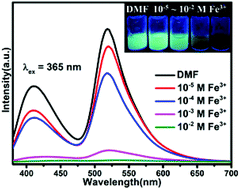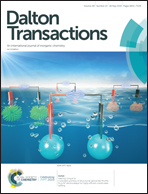Fabrication of a dual-emitting dye-encapsulated metal–organic framework as a stable fluorescent sensor for metal ion detection†
Abstract
Dye-loaded metal organic frameworks (MOFs) are regarded as one of the most fascinating luminescent materials for selective chemical sensing. Herein, a facile two-step synthesis procedure is reported for the successful encapsulation of fluorescein dye into porous zinc–adenine metal–organic framework (bio-MOF-1) crystals, and thus the aggregation-caused quenching of dye molecules can be eliminated in the confined MOF structure to further create dual emission centers. The as-prepared solid state fluorescein@bio-MOF-1 composite exhibits both the characteristic emissions of the fluorescein dye and bio-MOF-1, and host–guest energy transfer also occurs. Particularly, depending on the variety of the luminescence intensities of different metal ions incorporated in fluorescein@bio-MOF-1, such a host–guest system could be used for high-sensitive sensing of metal cations, especially for the drastic luminescence quenching of Fe3+ ions. The quenching effect coefficient (Ksv) for every metal ion detected is calculated, and the largest Ksv value for Fe3+ ions is determined to be 5072 M−1. Such an encapsulation strategy can be widely adopted to design new dye@MOF composites with multiple luminescent centers for metal cation sensing.



 Please wait while we load your content...
Please wait while we load your content...